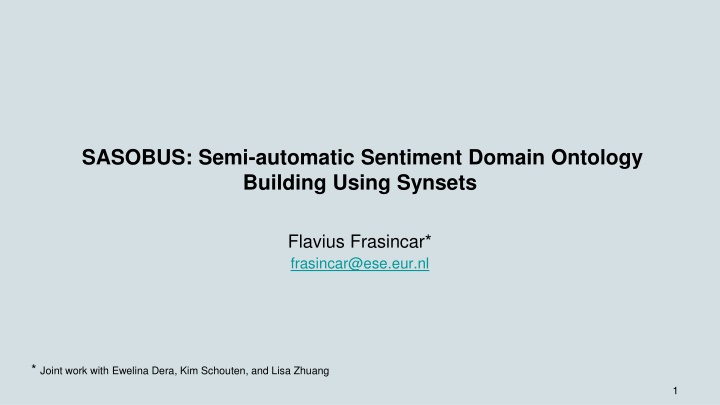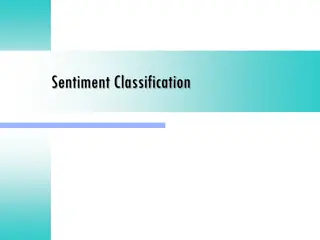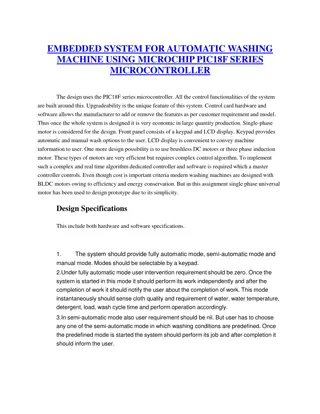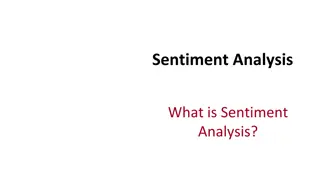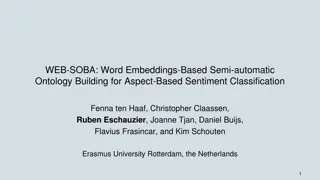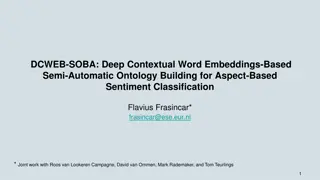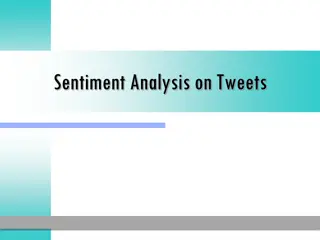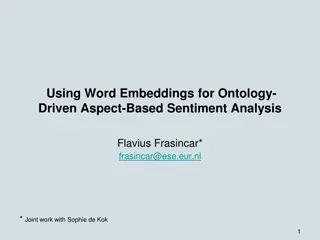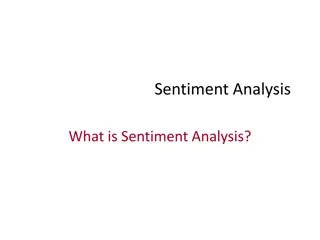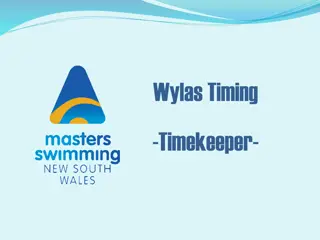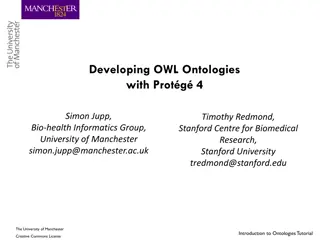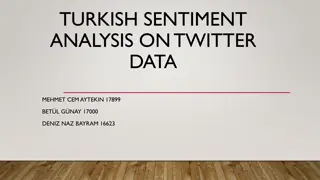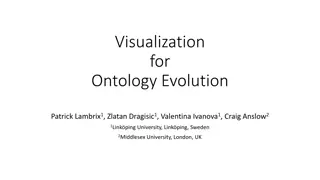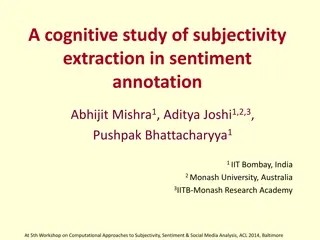SASOBUS: Semi-Automatic Sentiment Domain Ontology Building Using Synsets
Building on the need for automation due to the increasing volume and significance of online reviews, SASOBUS focuses on Aspect-Based Sentiment Analysis (ABSA). The motivation behind SASOBUS lies in the growth of sentiment mining for product reviews, particularly at the sentence level. Its approach includes ontology-based reasoning and machine learning to develop a semi-automatic domain sentiment ontology with synsets for broader coverage.
Download Presentation

Please find below an Image/Link to download the presentation.
The content on the website is provided AS IS for your information and personal use only. It may not be sold, licensed, or shared on other websites without obtaining consent from the author.If you encounter any issues during the download, it is possible that the publisher has removed the file from their server.
You are allowed to download the files provided on this website for personal or commercial use, subject to the condition that they are used lawfully. All files are the property of their respective owners.
The content on the website is provided AS IS for your information and personal use only. It may not be sold, licensed, or shared on other websites without obtaining consent from the author.
E N D
Presentation Transcript
SASOBUS: Semi-automatic Sentiment Domain Ontology Building Using Synsets Flavius Frasincar* frasincar@ese.eur.nl * Joint work with Ewelina Dera, Kim Schouten, and Lisa Zhuang 1
Contents Motivation Related Work Data Methodology Evaluation Conclusion 2
Motivation Growing number of reviews: In 2014: the number of reviews on Amazon exceeded 10 million Growing importance of reviews: 80% of the consumers read online reviews 75% of the consumers consider reviews important Reading all reviews is time consuming, therefore the need for automation 3
Motivation Sentiment miningis defined as the automatic assessment of the sentiment expressed in text (in our case by consumers in product reviews) Several granularities of sentiment mining: Review-level Sentence-level Aspect-level (product aspects are sometimes referred to as product features): Aspect- Based Sentiment Analysis (ABSA): Review-level Sentence-level [our focus here] 4
Motivation Aspect-Based Sentiment Analysis (ABSA) has two stages: Aspect detection: Explicit aspect detection: aspects appear literally in product reviews Implicit aspect detection: aspects do not appear literally in the product reviews Sentiment detection: assigning the sentiment associated to explicit or implicit aspects [our focus here] Three approaches for ABSA: Knowledge Representation (KR) Machine Learning (ML) Hybrid: current state-of-the-art, e.g., A Hybrid Approach for Aspect-Based Sentiment Analysis (HAABSA) proposed by Wallaart and Frasincar (2019) at ESWC 2019 5
Motivation HAABSA is a two-step approach for ABSA at sentence-level: 1. Ontology-based reasoning 2. Machine learning (backup solution) The domain sentiment ontology is manually constructed: Available only for some domains (restaurant and laptops) Limited coverage Research question: How to build in a semi-automatic manner a domain sentiment ontology for ABSA at sentence-level? In addition we aim to extend the ontology-representation by means of synsets (sets of synonyms) to increase ontology coverage 6
Related Work ABSA There are several approaches that we consider for ABSA: Ontology (Ont) by Schouten and Frasincar (2018): a two-step approach with ontology- based reasoning and a majority classifier as backup Content Attention Based Aspect-Based Sentiment Classification Model (CABASC) by Liu et al. (2018): combines two attention mechanisms, one that considers the relation between words, aspects, and the sentence, and one that considers word order Left-Center-Right separated neural network with Rotatory attention and multi-hops (LCR-Rot-hop) by Wallaart and Frasincar (2019): computes attention for left context, target, and right context in an iterative manner and using multiple hops and combinations of these, e.g., HAABSA is Ont+LCR-Rot-hop, where the majority classifier is replaced by the neural attention model LCR-Rot-hop (state-of-the-art 88% accuracy on the test data of SemEval 2016) 7
Related Work Ontology Building Ont without backup is used on 60% of the data instances, and gives an accuracy of 89% on the SemEval 2016 test data There are many approaches to build domain ontologies from domain corpora but none which targets the specifics of sentiment We follow the seminal work on ontology construction by Buitelaar et al. (2005): Term Selection: using domain pertinence and domain consensus with synsets by Meijer et al. (2014) Concept Formation: using user feedback Concept Hierarchy Construction: using the subsumption method by Sanderson and Croft (1999) 8
Data Domain corpus: Yelp Dataset Challenge 2017 data for restaurants 5,001 restaurant reviews 47,734 sentences Each review has text and star rating (0 to 5) Contrastive corpora: six popular and freely available English books from Project Gutenberg Alice's Adventures in Wonderland by Lewis Carrol Pride and Prejudice by Jane Austen The Adventures of Sherlock Holmes by Arthur Conan Doyle The Adventures of Tom Sawyer by Mark Twain Great Expectations by Charles Dickens 9
Data Training and testing data: SemEval 2016, Task 5, Subtask 1, Slot 3 for restaurants 3,365 opinions (target, aspect, and sentiment polarity, i.e., negative, neutral, and positive) Training data: 350 reviews 2000 sentences 1879 opinions (after removal of opinions with implicit aspects) Test data: 90 reviews 676 sentences 650 opinions (after removal of opinions with implicit aspects) 10
Data Example: Aspect categories: FOOD, AMBIENCE, DRINKS, LOCATION, RESTAURANT, and SERVICE Aspect attributes: PRICES, QUALITY, STYLE&OPTIONS, GENERAL, and MISCELLANEOUS 11
Data The most dominant sentiment is positive Almost all sentences have between 0 and 3 opinions 12
Methodology Semi-automatic Sentiment Domain Ontology Building Using Synsets (SASOBUS) SASOBUS implementation in Java: https://github.com/EJDera/SASOBUS HAABSA implementation in Python: https://github.com/ofwallaart/HAABSA Stanford CoreNLP 3.8.0 for sentence splitting, tokenization, lemmatization, and part-of-speech tagging Java API for WordNet Searching (JAWS) for obtaining synsets Word sense disambiguation (WSD) using the Simplified Lesk algorithm as it offers a good trade-off between accuracy and speed: The word sense associated to the synset with the gloss that has the largest overlap with the other words in the sentence is chosen as the disambiguated synset for the current word (if there is not overlap the most frequent synset is chosen) 13
Methodology Ontology Structure Differently than many approaches to ontology construction we have used synsets instead of words as these better capture the semantics of text The ontology structure is defined in Schouten and Frasincar (2018) and is based on three types of sentiment words: Type 1: Words that have always the same sentiment and are independent of an aspect (e.g., good ) Type 2: Words that belong to one or more aspects but not to all aspects and are always positive, negative, or neutral (e.g., delicious belongs to DRINKS#QUALITY and FOOD#QUALITY and is always positive) Type 3: Remaining sentiment words, which are words that are positive, negative, or neutral depending on the context (e.g., Fries Cold Negative and Beer Cold Positive) The domain sentiment ontology is represented in OWL 14
Methodology Ontology Structure The ontology skeleton has two main classes: Sentiment has two subclasses: Positive and Negative Mention has three subclasses: ActionMention: represents verbs EntityMention: represents nouns PropertyMention: represents adjectives Each Mention class has two subclasses (where <Type> denotes Action, Entity, or Property): GenericPositive<Type>:also a subclass of Positive GenericNegative<Type>: also a subclass of Negative GenericPositive<Type> and GenericNegative<Type> have initially defined subclasses that denote concepts associated to general synsets that use words such as hate , love , good , bad , disappointment , and satisfaction 15
Methodology Ontology Structure Concepts have two properties associated: lex: denotes an associated lexical representation synset: denotes an associated synset 16
Methodology Ontology Structure Each aspect has the form CATEGORY#ATTRIBUTE and for each <Type>Mention we generate two subclasses: <Category><Type>Mention <Attribute><Type>Mention We consider all six aspect categories: FOOD, AMBIENCE, DRINKS, LOCATION, RESTAURANT, and SERVICE We consider only three attributes: PRICES, QUALITY, STYLE&OPTIONS, as GENERAL, MISCELLANEOUS are too general For each <Category/Attribute><Type>Mention we add two subclasses: <Category/Attribute>Positive<Type> <Category/Attribute>Negative<Type> 17
Methodology Ontology Structure To each <Category/Attribute><Type>Mention we attach three properties: lex: denotes an associated lexical representation synset: denotes an associated synset aspect: denotes a corresponding aspect of the format CATEGORY#ATTRIBUTE There is a disjointWith relation between: <Category/Attribute>Positive<Type> <Category/Attribute>Negative<Type> 18
Methodology Term Selection We use Domain Pertinence (DP) to find terms that are specific for our domain but are not specific for other domains (contrastive domains): ?????(?) max ? ???(?) = (??????? ) ??????(?) ?? ???????(??) ???????(?) ?? ?????????(??) ?????? = ??????? = where: ? is a term found in our domain corpus ? ?????(?) and ??????(?) are the frequencies of the term t in our domain corpus ? and a contrastive corpus ??, respectively ??????? and ???????? are the number of times the term ? appears in our domain corpus ? and a contrastive corpus ??, respectively 19
Methodology Term Selection We use Domain Consensus (DC) to find terms that are prevalent in our domain (as an entropy-based method it obtains maximum when the word appears relatively equally often in all the documents in our domain): ???? = ?_???? ?,?? log(?_????(?,??)) ?? D ????(?,?) ?? D????(?,??) ?????(?,?) ?? ??????(??,?) ?_???? ?,? = ???? ?,? = where: ? is a found term and ? is a document in our corpus ? ?????(?,?) is the number of times term ? appears in document ? ?_???? ?,? is the normalized (relative to all freq.) frequency of ? in ? ???? ?,? is the frequency of ? in ? (relative to all terms in d) 20
Methodology Term Selection Last the relevance score of a term ? in the domain corpus ? is defined as: ???(?) max ?? ???(?) max ?? ?????????_??????? = ? (???(??))+ ? (???(??)) ? + ? = 1 where: ? defines the importance of the normalized domain pertinence score ? defines the importance of the normalized domain consensus score ? + ? = 1 as the relevance scores order depends only on the ratio ?/? In all the previous calculations we use synsets (if words have synsets associated) or lemmas (if words do not have synsets associated) as terms 21
Methodology Term Selection For each part-of-speech (???): verb (?), noun (?), and adjective (?) we determine a threshold: ?_?, ?_?, and ?_? that the relevance score needs to pass in order to have the term recommended to the user The objective function that needs to be maximized is defined by the harmonic mean of the ??????????_????????and the ????????_????????: 2 ? = 1 1 ??????????_????????+ ????????_???????? where: ??????????_???????? is the ratio of accepted terms by the user ????????_???????? is the number of accepted terms by the user as we want a high ??????????_????? and a high number of ????????_????? 22
Methodology Concept Formation The parameters to be optimized are: ?_?,?_?, ?_?, and ?_?,?_?, ?_? ?_?, ?_?, and ?_? We grid search to determine the optimal values: ? and ? in the interval [0,1] with a step of 0.1 ? in the interval [0.1,0.2] with a step of 0.01 The user accepts or rejects a recommended term If the user accepts a term, the user needs to decide if the accepted term is a: Aspect concept: concepts related to aspect but that do not carry sentiment (e.g., sushi is related to the aspect food and does not carry sentiment) Sentiment concept: concepts related to aspects but that carry sentiment (e.g., yummy is related to the aspect food and does carry a positive sentiment) 23
Methodology Concept Hierarchy Construction We learn hierarchical relations using the subsumption method: ?(?|?) ?1 ? ? ? < ?2 where: ?(?|?) represents the probability that the parent ? occurs given the child ? (the parent appears in more than a fraction ?1 of documents where the child also occurs) ?(?|?) represents the probability that the child ? occurs given the parent ? (the child appears in less than a fraction ?2 of documents where the parent also occurs) ?1= 0.2 and ?2= 1 (empirically determined in previous work) 24
Methodology Concept Hierarchy Construction The potential parents are ranked by the parent score: ??????_?????(?,?) = ?(?|?) The potential parents for verbs, nouns, and adjectives (types) that are aspect concepts are defined by <Category/Attribute><Type>Mention The potential parents for verbs, nouns, and adjectives (types) that are sentiment concepts are defined by <Category/Attribute><Polarity><Type> The user decides on the parent concept for a certain concept by scanning from the top the ranked list of potential parents and stopping when the parent has been found 25
Methodology Concept Hierarchy Construction The sentiment score for a sentiment concept is computed: ????? ?,? ? D(??????(?) ???? ?e???????? ?????? ????,?) ????? ?,? ???? ?e???????? ?????? ????,? ?????????_?????(?) = where: ??????(?) is the (Min-Max) normalized sentiment score from Yelp star rating for a review ? ????? ?,? is the number of times concept ? is used in the review ? ?e???????? ? is the set of sentiment concepts in the domain corpus ? 26
Methodology Concept Hierarchy Construction The potential parent classes <Category/Attribute><Type>Mention for aspect concepts are ranked by the ??????_????? The potential parent classes <Category/Attribute><Type>Mention for sentiment concepts are ranked by the ??????_?????, but the ?????????_????? is also taken in account yielding <Category/Attribute><Polarity><Type> parent classes (the ?????????_????? decides using a threshold of 0.5 which concept is shown first <Category/Attribute>Positive<Type> or <Category/Attribute>Negative<Type>) For example for the sentiment concept Attentive first ServicePositiveProperty is shown and then ServiceNegativeProperty For type 2 and type 3 sentiment concepts, the user can select more than one parent concept 27
Evaluation We have optimized the ontology learning parameters using grid search having as objective the harmonic mean of the ??????????_????????and the ????????_???????? on the Yelp Dataset Challenge 2017 for restaurants: 28
Evaluation sOnt represents the semi-automatically built ontology mOnt represents the manually built ontology by Schouten and Frasincar (2018) Classes denote all ontology classes and Concepts denoted accepted terms 29
Evaluation Observations: sOnt has more lexicalizations (around 3 per concept) than mOnt (around one per concept) sOnt has more synsets than concepts (there are concepts with more than one synset) E.g., the concept Atmosphere has two synset properties (two relevant meanings): a particular environment or surrounding influence a distinctive but intangible quality surrounding a person or thing The total time needed to create sOnt is larger than the total time needed to create mOnt The system time is mainly due to the used WSD algorithm (difficult to improve), but the system time is not really a problem as the computations can happen offline (user is not present) The user time needed to create sOnt is less than half the time needed to create mOnt and this is relevant in practice (the user part is the most expensive part in the system) 30
Evaluation wOnt represents a semi-automatically built ontology with same method as sOnt but using words instead of synsets as terms 31
Evaluation We use SemEval 2016, Task 5, Subtask 1, Slot 3 dataset for restaurants Observations: sOnt has lower accuracy (both out-of-sample and in-sample) than mOnt (~ 2% points) [as expected] wOnt has lower accuracy (both out-of-sample and in-sample) than sOnt (~ 3% points) Each hybrid method involving deep learning with sOnt has lower accuracy (both out-of- sample and in-sample) than a hybrid method with mOnt (~ 2% points) The hybrid methods based on CABASC have lower accuracy (both out-of-sample and in- sample) than the hybrid methods based on LCR-Rot-hop with both sOnt and mOnt [the results using mOnt are a confirmation of the findings of Wallaart and Frasincar (2019) Limitations: Used dataset for learning NLP components (especially the WSD algorithm) performance 32
Conclusion We have proposed SASOBUS, a semi-automatic method for domain sentiment ontology construction with synsets for ABSA at sentence-level: Term Selection Concept Formation Concept Hierarchy Construction We have used two restaurant datasets in our evaluation: Yelp Dataset Challenge 2017 data for ontology building SemEval 2016, Task 5, Subtask 1, Slot 3 data for measuring performance While the accuracy obtained using the semi-automatically built ontology has slightly decreased (~ 2% points) compared to the accuracy obtained using the manually built ontology, the user time is significantly lower (less than half) 33
Conclusion We have shown that using synsets instead of words improves the accuracy (~ 3% points) SASOBUS is useful for building domain sentiment ontologies for domains that to know have this knowledge resource Future work: Apply SASOBUS to other domains (e.g., laptops) in addition to restaurants Experiment with alternative approaches for the concept hierarchy construction (e.g., using word embeddings and clustering algorithms) Investigate alternative approaches for Word Sense Disambiguation (e.g., Adapted Lesk algorithm) Explore other solutions for computing the sentiment of a concept (e.g., neural networks) 34
References ABSA Kim Schouten and Flavius Frasincar. Ontology-Driven Sentiment Analysis of Product and Service Aspects. 15th Extended Semantic Web Conference (ESWC 2018), Lecture Notes in Computer Science, Volume 10843, pages 608-623, Springer, 2018. Qiao Liu, Haibin Zhang, Yifu Zeng, Ziqi Huang, and Zufeng Wu. Content Attention Model for Aspect Based Sentiment Analysis. 2018 World Wide Web Conference (WWW 2018), pages 1023-1032. ACM, 2018. Olaf Wallaart and Flavius Frasincar. A Hybrid Approach for Aspect-Based Sentiment Analysis Using a Lexicalized Domain Ontology and Attentional Neural Models. 16th Extended Semantic Web Conference, Lecture Notes in Computer Science, Volume 11503, pages 363-378, Springer, 2019. 35
References Ontology Building Mark Sanderson and Bruce Croft. Deriving Concept Hierarchies from Text. 22nd Annual International ACM SIGIR Conference on Research and Development in Information Retrieval (SIGIR 1999), 206-213, ACM, 1999. Paul Buitelaar, Philipp Cimiano, and Bernado Magnini. Ontology Learning from Text: Methods, Evaluation and Applications, IOS Press, 2005. Kevin Meijer, Flavius Frasincar, and Frederik Hogenboom. A Semantic Approach for Extracting Domain Taxonomies from Text. Decision Support Systems, Volume 62, 78-93, 2014. 36
